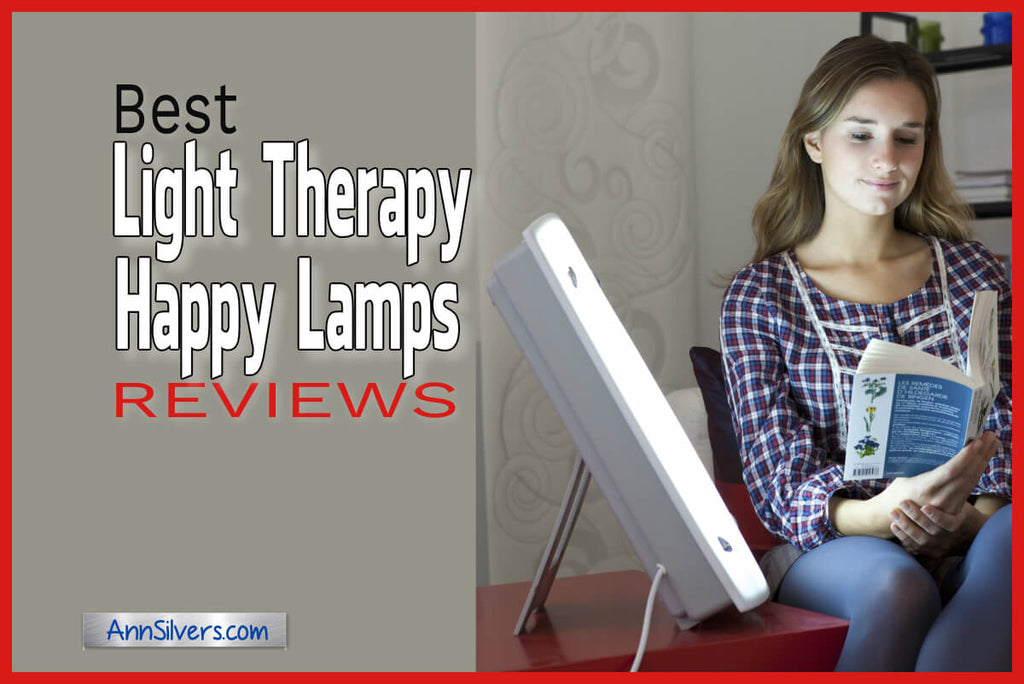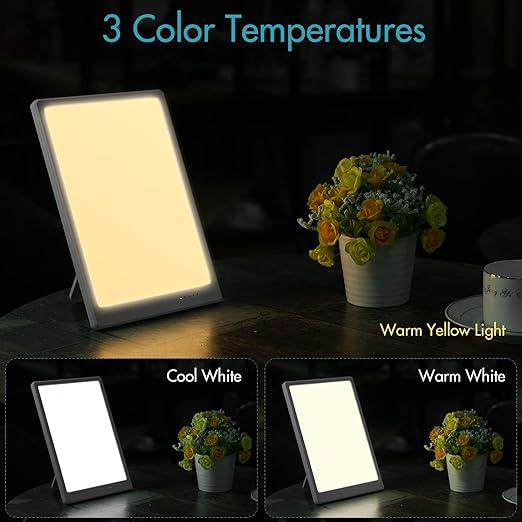Best Light Therapy Happy Lamps Reviews

Bright light therapy (AKA phototherapy) is a very effective way to counter seasonal depression, SAD, the winter blues, and many other mental health issues. It is so helpful for lifting mood during overcast weather and short daylight days that light therapy lamps are often called happy lamps.
Choosing a light therapy lamp can be overwhelming since there are many options out there. There are many different manufacturers of phototherapy lamps and many of them have multiple models.
I created this post to help you compare the pros and cons of different light therapy lamp models.
If you want to know more about the benefits of light therapy, the research behind its use as treatment for SAD, and other mental health issues, how to use a light therapy lamp, who should not use phototherapy lamps, and more, check out my post: How to Use Light Therapy for SAD, Winter Depression Treatment, and More
Post updated Nov 2024 for 2025 Light Therapy Lamp Reviews.
What I Cover in This Post
| What are Light Therapy Lamps and Boxes? |
| The Original Light Therapy Lamp |
| Considerations for Choosing a Light Therapy Lamp (Happy Lamp) |
| Large Light Therapy Lamp on a Stand |
| LED Light Therapy Happy Lamps Reviews |
Notes: The information in this article is based on my research. It is not intended as medical advice and does not replace personal advice from your personal medical professionals or personal research.

What are Light Therapy Lamps and Boxes?
I first heard of light therapy in the 1990s shortly after Dr. Norman Rosenthal started promoting the concept as a treatment for SAD (Seasonal Affective Disorder). At that time the device he used was commonly called a light box. They were fairly large and contained special high-power light bulbs.
I purchased one for myself in the early 1990s shortly after I moved to the Seattle area and found my energy waning as we hit our 70th day in a row without sunshine. To find a light box at that time, I had to buy one from a plant store.
The light box that I bought then was large and cumbersome. The sun came out shortly after my purchase so I only used it a few times that late winter. My experience with the impracticality of it made me never get it out again once I put it in the closet that spring.
A few years ago, a client told me how quickly he felt his mood lift once he used the light therapy lamp he had just purchased, I decided to do some research so that I could make specific recommendations for other clients.
I have been surprised by how far light boxes have come. And realize that they aren't called light boxes anymore. They are called light therapy lamps or happy lights.
The creation of high-power LED lights has been a game-changer. They instigated the development of much smaller light therapy lamps that appear to have several advantages over the original standardized style.
The Original Light Therapy Lamp
Most research on the effectiveness of light therapy for SAD and other conditions has been performed with a light therapy lamp close to the one Dr. Rosenthal designed in the 1980s.
The light therapy lamp that is commonly used in research is placed 16 to 24 inches from your face. It has:
- special high-power light bulbs,
- 10,000 lux light output,
- surface area of 1 ft by 1.5 ft, and
- a downward tilt.
Considerations for Choosing a Light Therapy Lamp (Happy Lamp)
First: Use a lamp that is specifically designed for light therapy. DO NOT use sunlamps, tanning lamps, or halogen lamps.
Your goal is to have a bright light with UV rays filtered out.
Here are some things to consider when you are choosing a light therapy lamp:
- Brightness
- UV rays exclusion
- Size
- Angle
- Convenience
1. Brightness
The recommended light exposure is 10,000 lux for 20 to 60 minutes.
Ordinary light bulbs are NOT at all useful for therapeutic purposes. 10,000 lux light therapy lamps are 20 times stronger than ordinary light bulbs.
The standardized light therapy lamp that is 1 ft by 1.5 ft sits at a distance of 16 to 24 inches from your face.
If you choose a smaller or less bright light therapy lamp or setting (many of the new models allow for different light intensity settings), longer exposure time and closer placement may be able to give you a similar effect.
2. UV rays exclusion
The UV range of light rays is NOT what we’re going for. Those rays need to be filtered out so that they don’t damage your eyes.
Look for brands that specify removal of at least 99% of the UV rays. The older style light therapy lamps with bulbs typically have about 99% of the UV rays removed. Most LED models say “UV-free.”
3. Size
For the most part, light therapy research is based on light therapy lamps that have a surface area of approximately 1 ft by 1.5 ft. A 2024 bright light therapy study used a lamp that was even bigger: about 23" x 12" (but it was only 5000 lux).
Most LED light therapy lamps being sold today are smaller than this.
While people are having positive results with sizes smaller than those used in the research, be cautious about going too small. Light sources that are too small may not project a broad enough area to keep your eyes in range during use.
4. Angle
The type of therapy happy lamp used in the original research needed to be angled so that the light projected downward toward your eyes to reduce glare. I found that very few current bright light therapy LED lamps are designed this way. In fact, many of the new LED lights are angled up.
If you use one of the styles that don’t angle down, it may be best to use it to your side in your peripheral vision range so that your eyes are getting light but not directly. You also might be able to mimic the downward angle by placing the lamp higher (ie on some books or hanging on the wall).
For more on how to use light therapy lamps, check out my blog post: How to Use Light Therapy for SAD, Winter Depression Treatment, and More
5. Convenience
You’ll be sitting near the phototherapy lamp for about a half-hour each morning so think about what you want to be doing during that time (ie reading, checking emails, eating breakfast, working on the computer, writing, knitting, watching TV,. . .).
You are more likely to use a therapy lamp that is practical for you. Consider where you’ll be using it and whether a particular model fits your needs.
A less ideal light therapy lamp that you’ll use is better than one that meets all the research-based criteria but isn’t convenient for you. It definitely won’t be helpful to you if it's sitting in your closet all winter.
Some convenience points of many LED light therapy lamps compared to the original bulb type:
-
The LED lamps are much smaller, take up less space, and are more portable.
-
The LED lamps often have multiple brightness settings (or dimmers).
-
The LED lamps often have timers.
-
LED lights have an extreme long life, unlike the bulbs that need to be replaced in the original style of light therapy lamp.
Large Light Therapy Lamp on a Stand
Carex makes several light therapy lamps with some features of the lamps used in the original research, but they have updated their design to include LED lamps.
Pros: They have a large surface, 10,000 lux, and a downward tilting function like that used in original research studies.
Cons: They are relatively expensive and cumbersome.
Here's an example of a Carex model:
Carex Day-Light Classic Plus Bright Light Therapy Lamp
| Cost | $119 |
| Size | 31" tall, 16"x12" |
| Tilt | Tilts down, adjustable |
| Lux | 10,000 |
| UV | 99.3% removed |
| Adjustable brightness | 2 settings |
| Distance for use | 12" to 14" |
| Timer | No |
| Guarantee | 5 year |
| Amazon reviews | 70% are 5 star |
There are some other brands that make similar large light therapy lamps, but they are all expensive when compared to LED light therapy lamps and all the ones that I found suffer from a large number of complaints by reviewers.
LED Light Therapy Happy Lamps Reviews
The newer-style LED phototherapy lamps don't usually tilt down. Many are flat and most tilt up. Some models offer the option of attaching to the wall.
From reading reviews from users on Amazon, many people are getting positive results from this style of lamp.
Here are a few examples.
Fitfirst Light Therapy Lamp, 15000 Lux Simulated Sunlight, UV-Free LED Lamp
| Cost | $30 when on sale | |
| Size |
|
|
| Tilt | tilts up | |
| Lux | 15,000 | |
| UV | UV-free LED | |
| Distance for use | 5.5" to 20" | |
| Adjustable brightness | 4 levels, 3 color hues | |
| Timer | 4 settings | |
| Stand | yes | |
| Additional pro | slender - portable, doesn't require much space when using | |
| Guarantee | 30 day Amazon warranty | |
| Amazon reviews |
over 70% 5 stars |
Verilux HappyLight Touch - UV-Free LED Therapy Lamp

| Cost | $70 |
| Size | 0.51"D x 7.48"W x 11.73"H |
| Tilt | Tilts up |
| Lux | 10,000 |
| UV | UV-free LED |
| Distance for use | 5.5" to 20" |
| Adjustable brightness | 4 levels, 3 color hue options |
| Timer | yes |
| Stand | detachable stand PLUS hole for hanging |
| Additional pro | slender - portable, doesn't require much space when using |
| Additional pro | "leader in healthy lighting for more than 65 years, and as the creator of the original HappyLight" |
| Guarantee | 3 year |
| Amazon reviews |
over 75% 5 stars |
Circadian Optics Light Therapy Lamp - LED Happy Mood Lamps for Seasonal Sunlight Changes
Circadian Optics offers a variety of happy lights in different shapes and formats. Their designs could help you fit bright light therapy into your decor.
| Cost | $75 |
| Size | not provided |
| Tilt | Tilts up |
| Lux | 10,000 |
| UV | UV-free LED |
| Distance for use | 16" to 18" |
| Adjustable brightness | 3 levels |
| Timer | No |
| Stand | Not adjustable |
| Additional pro | offers a variety of unique decor-friendly styles |
| Cons | Can't hang it on a wall, less portable than the flat options above which are about the size of a tablet |
| Guarantee | 4 year |
| Amazon reviews |
over 70% 5 stars |
Disclaimer: Nothing in this post should be taken as medical advice. It is simply a summary of my research. Check with your own doctor and medical professionals before using a light therapy lamp.
I may receive a small commission from purchases made via links on this page, but they do not impact your cost.
- Ann Silvers










Comments 0